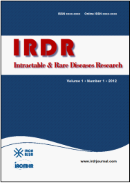Drug Discov Ther. 2016;10(6):307-313. (DOI: 10.5582/ddt.2016.01230)
Fabrication of Janus particles composed of poly (lactic-co-glycolic) acid and hard fat using a solvent evaporation method.
Matsumoto A, Murao S, Matsumoto M, Watanabe C, Murakami M
The feasibility of fabricating Janus particles based on phase separation between a hard fat and a biocompatible polymer was investigated. The solvent evaporation method used involved preparing an oil-in-water (o/w) emulsion with a mixture of poly (lactic-co-glycolic) acid (PLGA), hard fat, and an organic solvent as the oil phase and a polyvinyl alcohol aqueous solution as the water phase. The Janus particles were formed when the solvent was evaporated to obtain certain concentrations of PLGA and hard fat in the oil phase, at which phase separation was estimated to occur based on the phase diagram analysis. The hard fat hemisphere was proven to be the oil phase using a lipophilic dye Oil Red O. When the solvent evaporation process was performed maintaining a specific volume during the emulsification process; Janus particles were formed within 1.5 h. However, the formed Janus particles were destroyed by stirring for over 6 h. In contrast, a few Janus particles were formed when enough water to dissolve the oil phase solvent was added to the emulsion immediately after the emulsification process. The optimized volume of the solvent evaporation medium dominantly formed Janus particles and maintained the conformation for over 6 h with stirring. These results indicate that the formation and stability of Janus particles depend on the rate of solvent evaporation. Therefore, optimization of the solvent evaporation rate is critical to obtaining stable PLGA and hard fat Janus particles.







